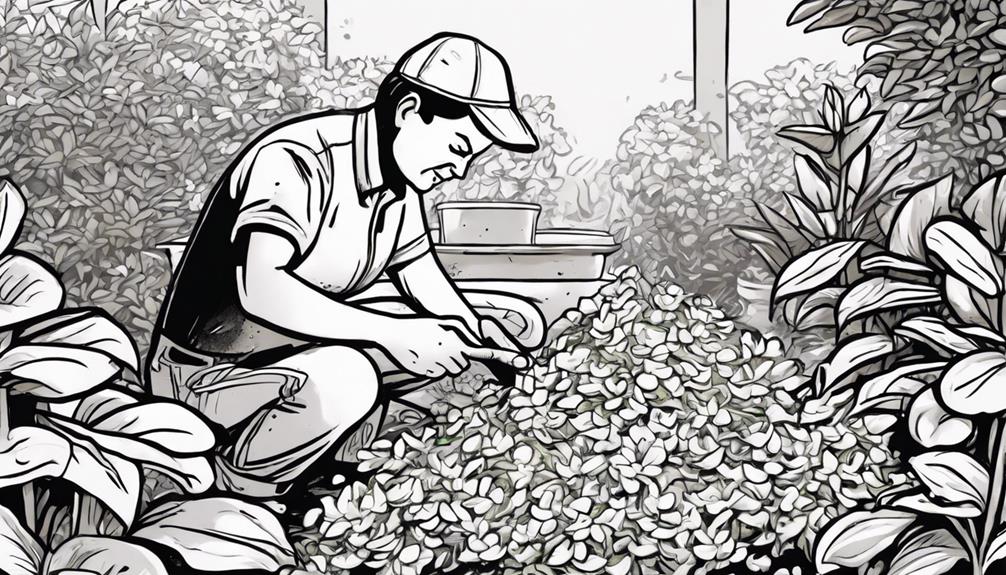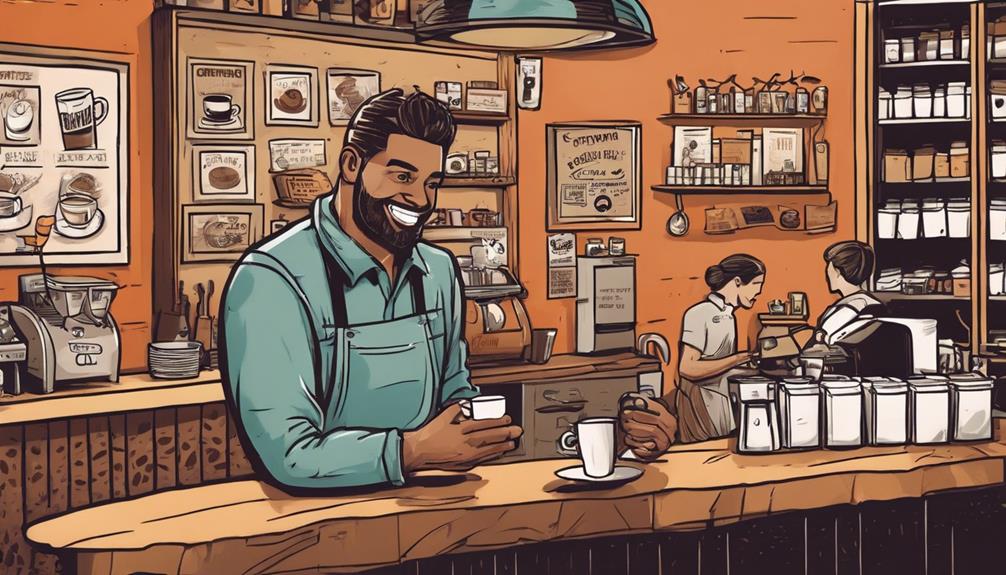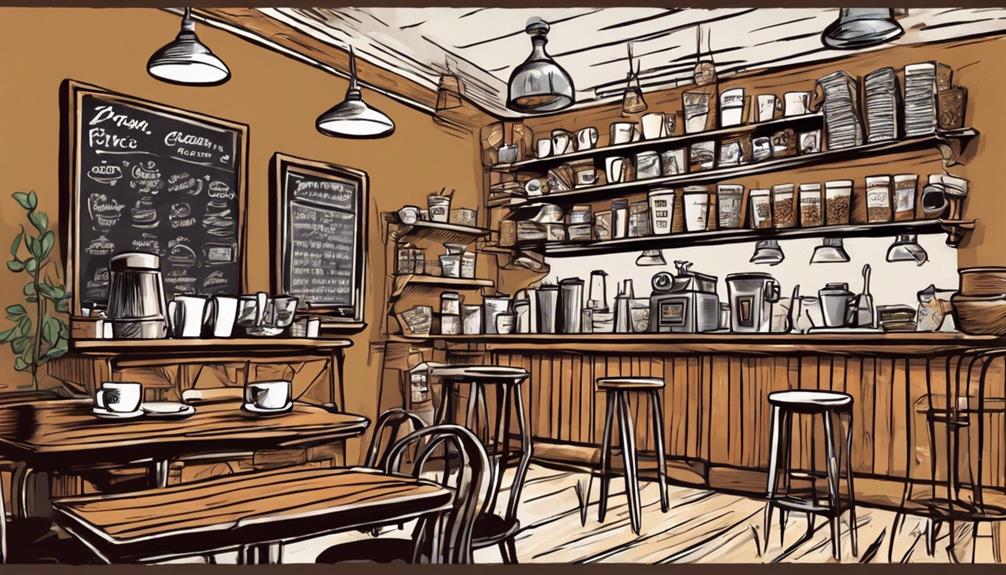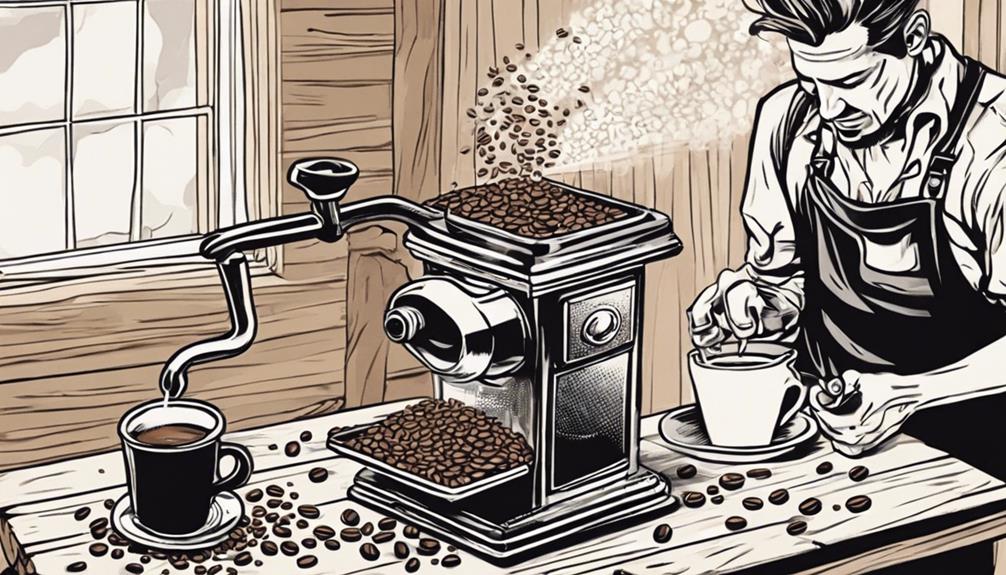Improve the blooming of your gardenias with coffee grounds! Enhance soil nutrients and improve water retention. Create an acidic environment for your acid-loving plants. Help in the absorption of essential nutrients like nitrogen and potassium. Promote healthy root growth and soil fertility. Mix the grounds directly into compost or soil. Create a liquid fertilizer or acidic water mixture. Keep the soil pH balanced using this natural method. Remember to use used, dry grounds and avoid sweetened types. Store and apply properly for monthly care during growth. Improve the health and blooming of your gardenias by using coffee grounds effectively.
Key Takeaways
- Mix dried coffee grounds into soil or compost.
- Apply coffee ground liquid fertilizer monthly.
- Use used coffee grounds for gardenias.
- Store coffee grounds properly for best results.
- Avoid sweetened or flavored coffee grounds.
Benefits of Coffee Grounds for Gardenias
Enhance your gardenias' growth by incorporating coffee grounds, which provide essential nutrients and lower soil pH for the best development. Coffee grounds are rich in nitrogen, phosphorus, and potassium, crucial for the overall health of your gardenias. These nutrients are necessary for promoting lush foliage and vibrant blooms in acid-loving plants like gardenias.
Additionally, coffee grounds release micronutrients as they decompose, further enhancing the soil quality necessary for ideal growth.
Mixing coffee grounds into compost can improve water retention in the soil, ensuring that your gardenias receive sufficient moisture for their development. Supplementing the use of coffee grounds with ericaceous feed can provide an additional source of nutrients specifically tailored to the needs of acid-loving plants like gardenias.
The combination of these elements creates a fertile environment that supports healthy growth and flourishing blooms in your gardenias.
Methods of Applying Coffee Grounds
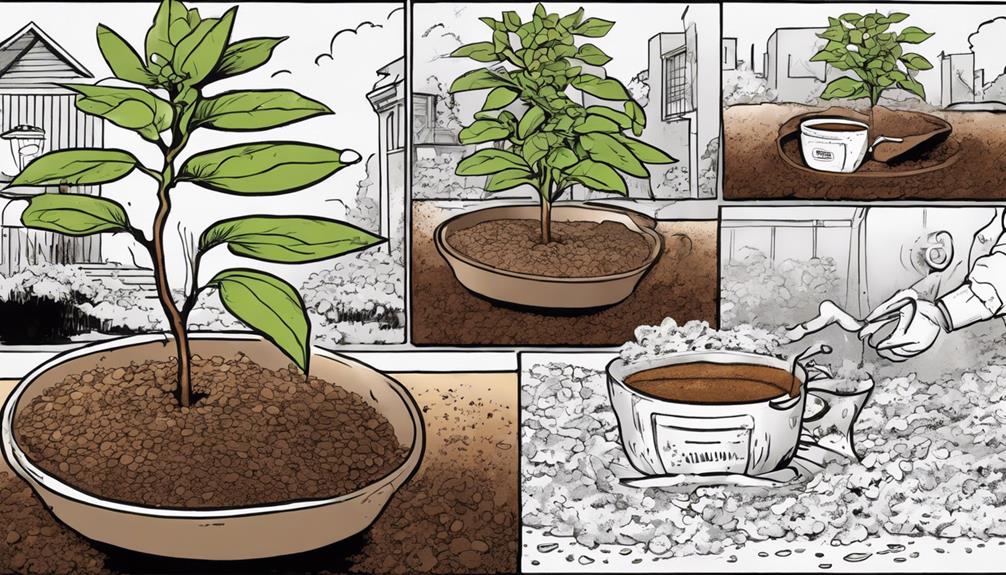
To optimize the growth of your gardenias effectively, consider various methods of incorporating coffee grounds into your gardening routine.
One method is mixing coffee grounds into compost, which enhances water retention and provides essential nutrients for your gardenias.
Another way to apply coffee grounds is by creating a mixture of coffee grounds and water to boost soil acidity, benefiting your gardenias.
Additionally, directly adding coffee grounds to the soil or compost acts as a mild, slow-release feed for your plants.
Making a liquid fertilizer from coffee grounds can also be advantageous for your gardenias during the growing season.
Remember to store your coffee grounds in an air-tight container to preserve their nutrients for future use in the garden.
Instant Coffee for Gardenias

Using instant coffee for your gardenias may not be as efficient as utilizing fresh coffee grounds due to its lower nutrient levels and reduced acidity. Instant coffee lacks the richness of nutrients found in fresh coffee grounds, which are beneficial for plant growth.
Additionally, roasted coffee, whether in instant form or not, has reduced acidity levels compared to fresh coffee grounds. This lower acidity can impact its ability to lower soil pH, which is vital for acid-loving plants like gardenias.
To ensure optimal growth for your gardenias, consider incorporating fresh coffee grounds into your compost. Coffee grounds are valuable for boosting acidity levels in compost, providing a nutrient-rich environment for your gardenias to thrive.
Home composting with coffee grounds is a sustainable practice that not only recycles waste but also offers free nutrients for your gardenias. By learning how to create compost at home, you can easily enhance the health and essentiality of your gardenias.
Turning Coffee Grounds Into Fertilizer
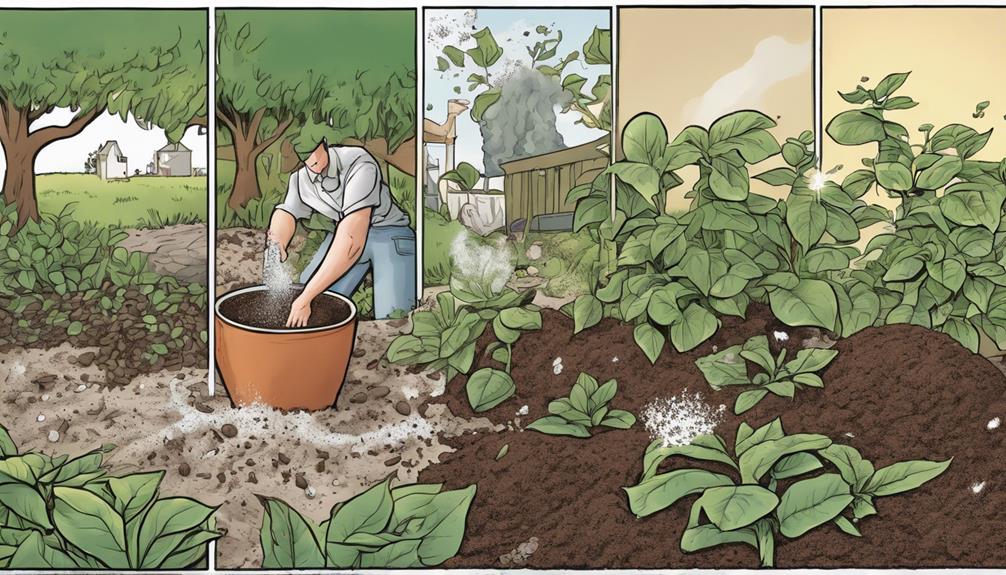
Create a nutrient-rich liquid fertilizer for your gardenias by mixing coffee grounds with water. This homemade liquid fertilizer is a sustainable and cost-effective way to provide essential nutrients to your gardenias.
To make this fertilizer, simply mix used coffee grounds with water in a container and let it steep for a few hours. You can then apply this nutrient-rich liquid to your gardenias once a month during the growing season for best results.
Storing coffee grounds in an air-tight container is essential to preserve their nutrients for future use in making fertilizer. Obtaining used coffee grounds from coffee shops is a great way to recycle and repurpose waste while benefiting your gardenias.
When applying the coffee ground and water mixture, consider spritzing it around the base of your gardenias for a lighter application that still provides the necessary nutrients.
Ph and Soil Structure Role
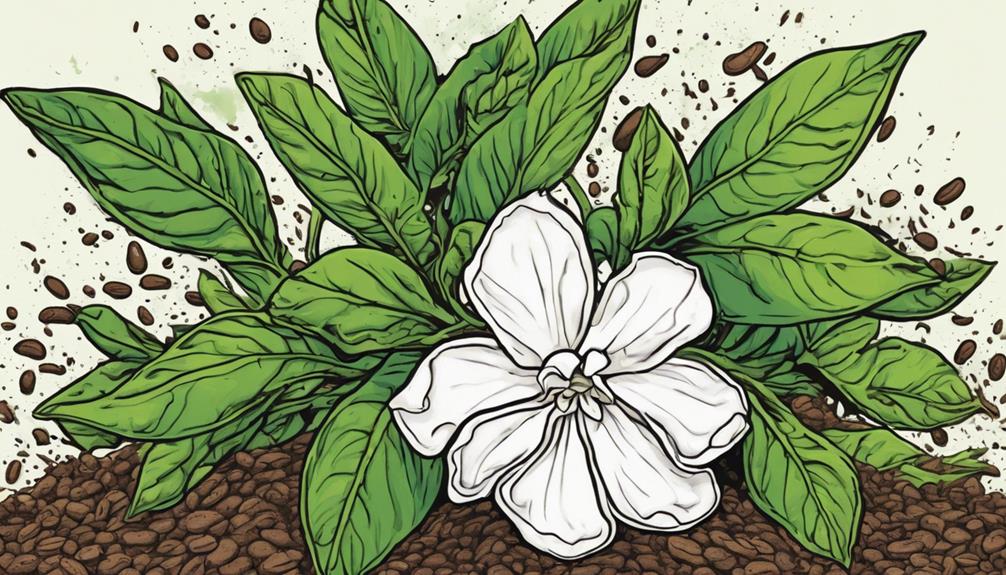
Improving gardenia soil structure and pH levels is necessary for promoting healthy growth and blooming. Gardenias thrive in well-draining soil with good aeration, which coffee grounds can help achieve by enhancing soil composition. This improved structure also aids in preventing root rot, a common issue in gardenias.
The natural acidity of coffee grounds plays an important role in maintaining the ideal pH level for these plants. Additionally, the acidity contributes to better moisture retention, which is essential for the health of gardenias. By using coffee grounds, gardeners can create an environment that deters pests naturally, further enhancing the overall health of their gardenias.
Ensuring the right soil structure and pH levels through the application of coffee grounds not only benefits the immediate growth and blooming of gardenias but also supports their long-term health and resilience.
Using Coffee Grounds for Bloom
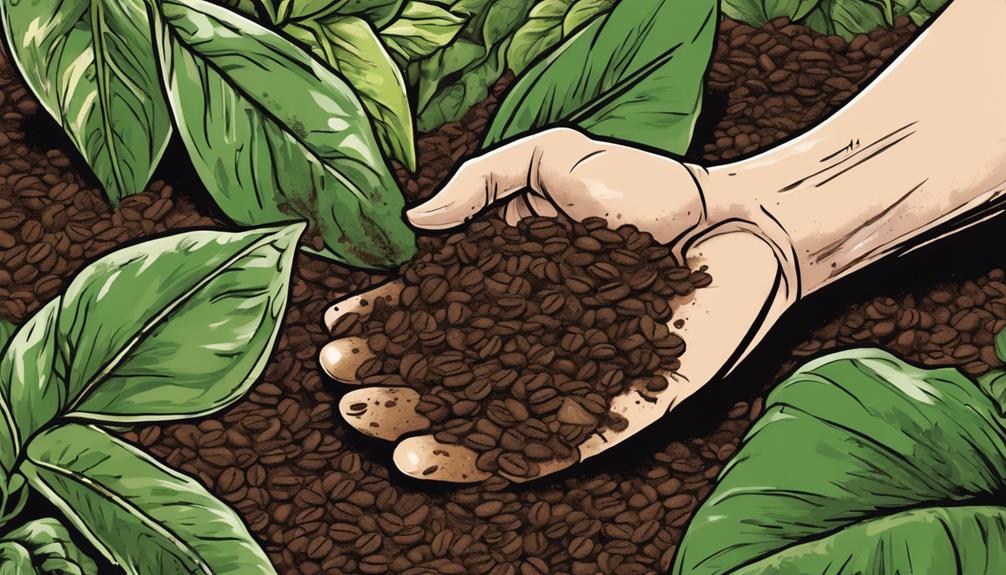
Enhance your gardenias' bloom potential by utilizing coffee grounds in your garden. The soil acidification benefits from coffee grounds help create an ideal environment for vibrant blooms. In addition to boosting your gardenias’ bloom potential, using coffee grounds in your garden also contributes to natural lawn care. The organic matter in coffee grounds helps improve soil structure and water retention, promoting overall soil health. This natural approach to lawn care can lead to healthier, more vibrant plants throughout your garden.
Providing nutrient-rich support, coffee grounds can enhance the overall health and beauty of your gardenias.
Soil Acidification Benefits
Enhancing gardenia bloom by utilizing coffee grounds involves leveraging their soil acidification benefits. When you apply coffee grounds to your gardenias, you are not only helping them thrive but also improving the soil conditions for ideal growth. Here's how coffee grounds benefit your gardenias through soil acidification:
| Benefits | Acidification | Coffee Grounds |
|---|---|---|
| Promotes Nutrient Absorption | Increases soil acidity, benefiting acid-loving plants like gardenias | Contains organic matter that gradually releases nutrients |
| Enhances Soil Structure | Improves soil texture and aeration | Adds organic material to the soil, aiding in better drainage |
| Supports Blooming | Helps gardenias access essential nutrients for vibrant blooms | Slowly decomposes, providing a steady nutrient supply |
| Boosts Overall Health | Contributes to healthy foliage and root development | Enhances soil fertility, promoting plant growth |
Nutrient-Rich Bloom Support
To nurture nutrient-rich blooms in your gardenias, consider incorporating coffee grounds into your soil maintenance routine. Coffee grounds provide essential nutrients like nitrogen, phosphorus, and potassium, supporting the bloom of your gardenias.
Here's how coffee grounds can help your gardenias thrive:
- Enhanced Flower Production: The nutrients released from decomposing coffee grounds can greatly improve flower production in gardenias.
- Improved Acidity Levels: Applying coffee grounds to the soil can help enhance acidity levels, creating the ideal environment for healthy blooms in your gardenias.
- Slow-Release Properties: Coffee grounds have gradual-release properties, ensuring a sustained nutrient supply for your gardenias, making them a sustainable option for bloom support.
- Sustainable Bloom Boost: Regularly supplementing your gardenias with coffee grounds can lead to vibrant, long-lasting blooms, making it a sustainable and efficient way to support their growth.
Coffee Grounds for Gardenia Health

Improve the pH levels of your gardenia soil by adding coffee grounds, providing the needed acidity for best growth.
The rich nutrients in coffee grounds will nourish your gardenias, boosting their overall health and essentiality.
Soil Ph Enhancement
Using coffee grounds in your gardenias' soil can help adjust its pH level to create a more acidic environment, important for their best health and growth. Here's how coffee grounds can enhance your gardenias' soil pH:
- Lower pH Levels: Coffee grounds contribute acidity to the soil, benefiting acid-loving plants like gardenias.
- Nutrient Absorption: The acidity from coffee grounds aids gardenias in efficiently absorbing vital nutrients like nitrogen, phosphorus, and potassium.
- Soil Quality Improvement: Incorporating coffee grounds enhances soil quality by boosting microbial activity and improving structure, promoting overall gardenia health.
- Optimal pH Balance: Gardenias prefer slightly acidic soil, and coffee grounds assist in maintaining the ideal pH level for their growth and blooming.
Nutrient-Rich Soil
Adjusting your gardenias' soil pH with coffee grounds not only creates a more acidic environment but also enriches the soil with essential nutrients for their best health and growth. Coffee grounds are a fantastic addition to gardenia soil, providing essential nutrients such as nitrogen, phosphorus, and potassium. When these grounds decompose, they release micronutrients that are vital for the healthy growth of your gardenias. Mixing coffee grounds into compost not only improves water retention but also boosts the nutrient levels available to your plants. To ensure a well-rounded fertilizing approach, consider supplementing with ericaceous feed alongside coffee grounds. By applying coffee grounds weekly, you can enhance the soil acidity, creating the ideal environment for acid-loving plants like gardenias.
| Benefits of Coffee Grounds for Gardenias |
|---|
| Enriches soil with essential nutrients |
| Releases micronutrients during decomposition |
| Improves water retention in compost |
| Boosts nutrient levels for gardenias |
| Enhances soil acidity for acid-loving plants |
Tips for Using Coffee Grounds
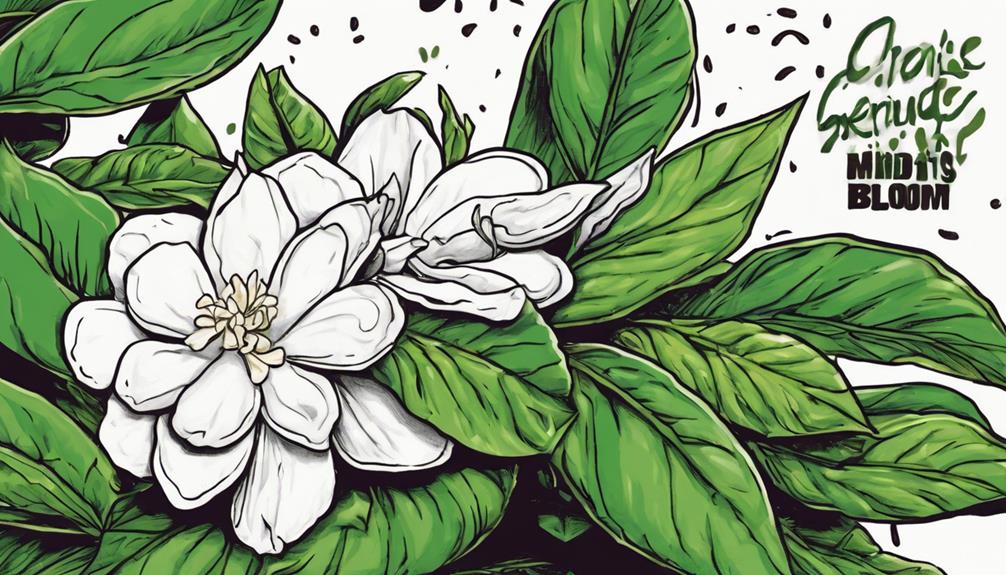
For best results, it's crucial to use coffee grounds in your gardenias with moderation to avoid over-acidifying the soil. Here are some tips to help you make the most of using coffee grounds in your garden:
- Dry Them Out: Make sure the coffee grounds are fully dried before applying them to your garden to prevent mold growth.
- Mix with Compost: Combining coffee grounds with compost or other organic materials can provide a balanced nutrient source for your plants.
- Avoid Flavored or Sweetened: Steer clear of using coffee grounds from flavored or sweetened coffee as they may contain additives harmful to your plants.
- Rotate with Other Amendments: Alternating the use of coffee grounds with other soil amendments can help maintain soil health and prevent nutrient imbalances.
Frequently Asked Questions
How Do You Add Coffee Grounds to Gardenias?
To add coffee grounds to gardenias, mix them into the soil for essential nutrients. Combine with compost to improve water retention and acidity. Avoid direct sprinkling to prevent acidity buildup. Use a mixture of coffee grounds and water as liquid fertilizer monthly for best results.
Is Miracle Gro Bloom Booster Good for Gardenias?
Wondering if Miracle Gro Bloom Booster is suitable for your gardenias? Absolutely, it's a great choice! This water-soluble fertilizer packed with essential nutrients like phosphorus supports blooming and root development. Regular application can result in vibrant blooms.
Can I Just Sprinkle Coffee Grounds on Plants?
You shouldn't just sprinkle coffee grounds on plants. Mixing them in soil or compost is better. It prevents mold and acidity issues. Incorporating grounds gradually releases nutrients for plants. Mix with organic matter for soil improvement.
What Is the Best Fertilizer for Gardenias to Bloom?
For your gardenias to bloom beautifully, choose an acidic fertilizer. It helps maintain the perfect soil pH. Look for nitrogen, phosphorus, and potassium-rich options. An ericaceous feed designed for acid-loving plants can work wonders.
Conclusion
So next time you make your morning brew, don't toss those used coffee grounds! Sprinkle them around your gardenias to give them a boost of nutrients and help them bloom beautifully. You can also use coffee grounds as a natural fertilizer for other acid-loving plants, such as azaleas and rhododendrons. In addition to providing nutrients, the coffee grounds can also help improve the moisture retention and aeration of the soil. Some gardeners even swear by applying coffee grounds to lawn as a way to promote healthy grass growth and deter pests.
Imagine your gardenias thriving, their leaves vibrant and flowers bursting with color thanks to the power of coffee grounds.
It's a simple and natural way to care for your plants and enjoy a cup of coffee at the same time.
Happy gardening!
